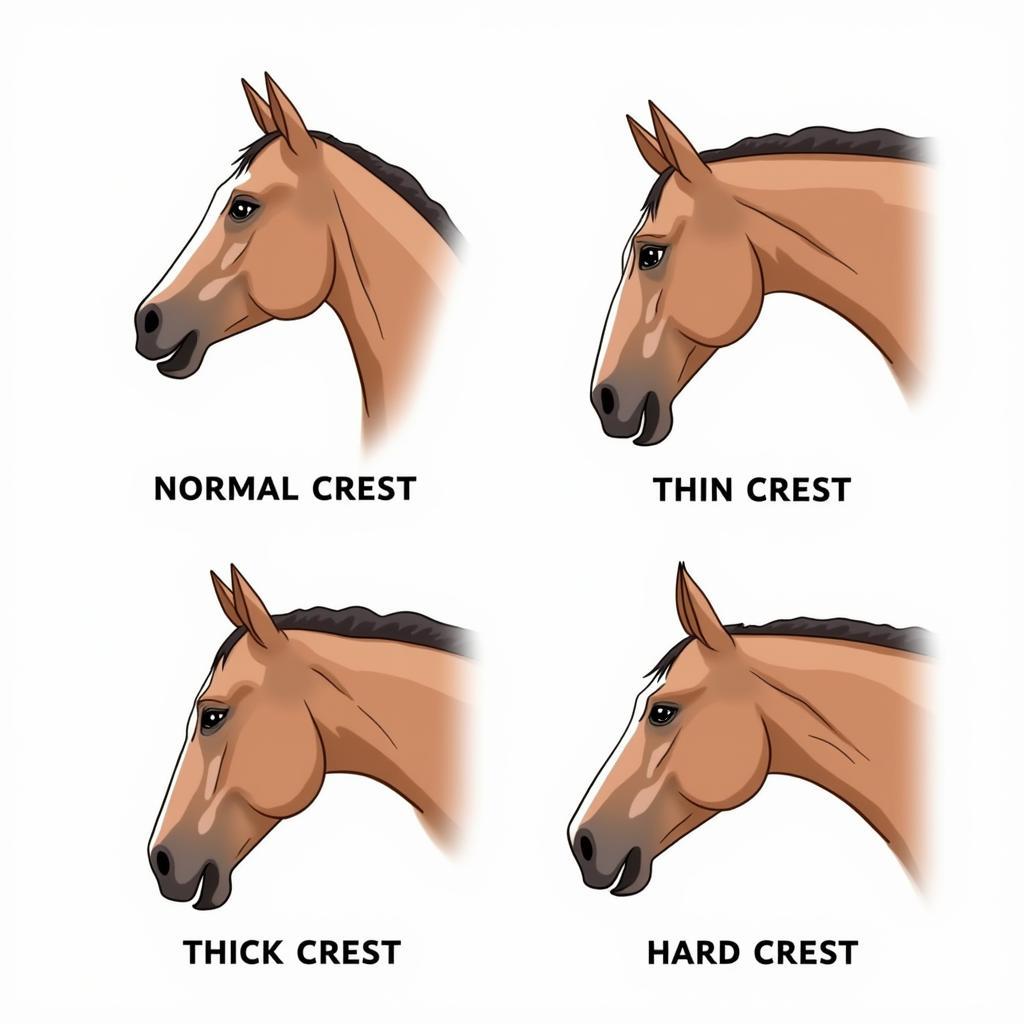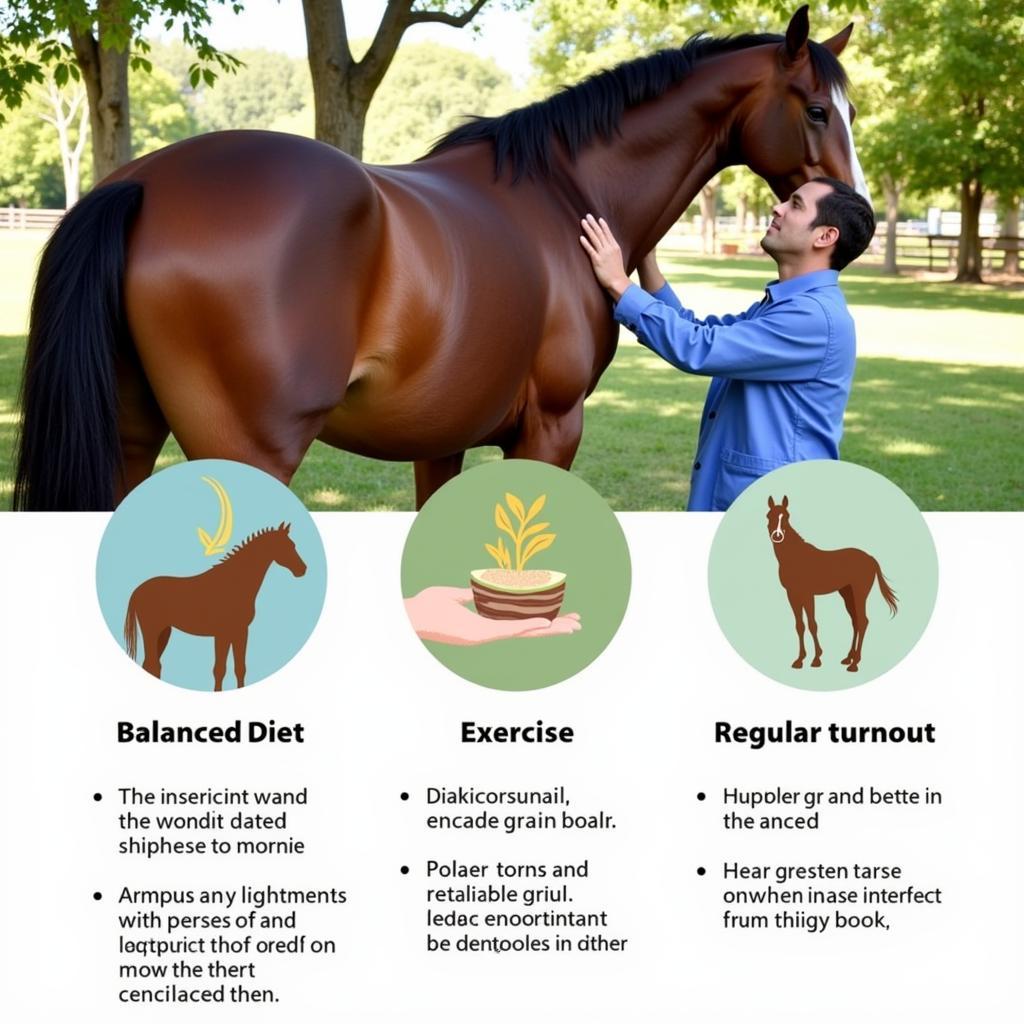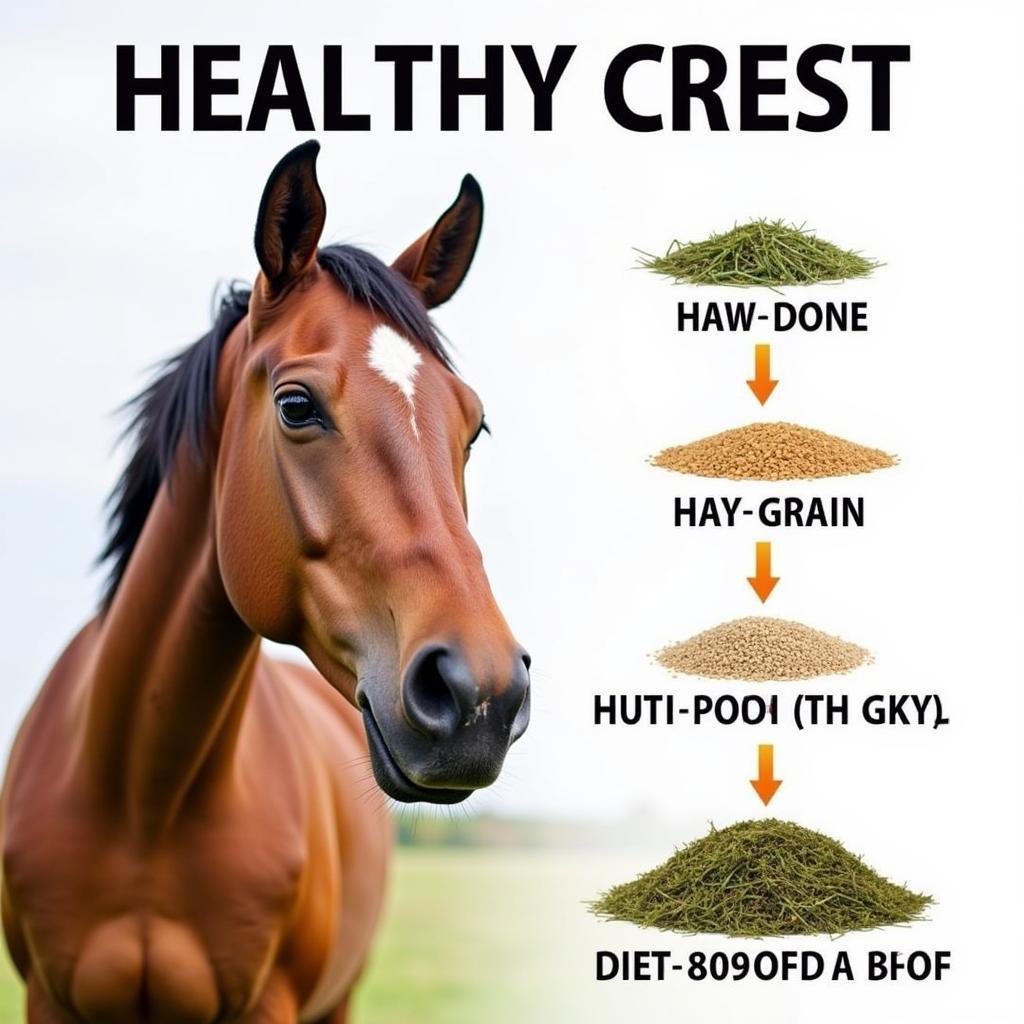A horse’s crest, that prominent arch along the top of their neck, is more than just a beautiful feature. It plays a crucial role in their overall health and well-being, reflecting their diet, age, and even hormonal balance. Learning to interpret the Crest On A Horse can provide valuable insights into their condition.
What Exactly is a Crest on a Horse?
The crest is essentially a muscular and fatty deposit along the topline of a horse’s neck, extending from just behind the ears to the withers. Its size and shape can vary significantly depending on several factors, and understanding these variations is key to proper horse care. For instance, a well-developed crest is often seen in stallions due to higher testosterone levels, contributing to the powerful appearance we associate with them. However, an excessively large crest can also be a sign of underlying health issues. If you’re concerned about your horse’s weight, check out our article on weight loss in horses.
Different Types of Crests and Their Meanings
Several different types of crests can be observed in horses, each with its own implications for their health:
- Normal Crest: A firm, well-defined crest that is proportional to the horse’s overall build. This is the ideal and indicates a healthy, well-nourished horse.
- Thin Crest: A thin or underdeveloped crest may suggest poor nutrition or underlying illness.
- Thick or Cresty Neck: This often indicates an overweight horse, possibly due to a diet too high in sugars and starches. This type of crest can be associated with insulin resistance and metabolic issues.
- Hard Crest: A hard, inflexible crest often accompanies Cushing’s disease, a hormonal disorder common in older horses.
Horses with excessively large crests can experience discomfort, especially when wearing a bridle or halter. Proper management of their diet and exercise regimen is crucial for maintaining a healthy crest and overall well-being.
 Different Horse Crest Types
Different Horse Crest Types
The Role of Diet in Crest Development
Diet plays a vital role in the size and condition of a horse’s crest. A diet high in carbohydrates, particularly non-structural carbohydrates (NSC) like sugars and starches, can contribute to fat deposition in the crest. This is particularly true for certain breeds, such as ponies and some draft breeds, which are genetically predisposed to easy weight gain. If your horse is a “grain horse” you should pay extra attention to their diet, you can learn more about them here: grain horse. Managing NSC intake is crucial for maintaining a healthy crest and preventing metabolic issues.
How to Manage a Horse with a Large Crest
If your horse has a large crest, it’s essential to consult with a veterinarian to rule out any underlying medical conditions. They can advise on appropriate dietary changes and exercise programs to help your horse lose weight and improve their overall health. This might include reducing the amount of grain and increasing the amount of forage in their diet, as well as implementing a regular exercise routine. You can find helpful information about the anatomy of a horse here: printable parts of a horse.
 Managing a Horse with a Large Crest
Managing a Horse with a Large Crest
Why is my horse’s crest so big?
A large crest on a horse can be a sign of obesity, often caused by excessive intake of carbohydrates and insufficient exercise. It can also be a symptom of Cushing’s disease, a hormonal disorder.
What does a hard crest on a horse mean?
A hard crest on a horse is often a sign of Cushing’s disease, a hormonal imbalance that commonly affects older horses. It’s crucial to consult a vet for diagnosis and management.
How do I reduce my horse’s crest size?
Reducing a horse’s crest size requires a combination of dietary adjustments and increased exercise. Consult a vet for a personalized plan, and remember that this is a gradual process. If you’re a proud horse dad and looking for something to show your love, check out our cool horse dad shirt.
 Horse with a Healthy Crest and Diet
Horse with a Healthy Crest and Diet
Conclusion
The crest on a horse provides valuable insights into their overall health and well-being. By understanding the different types of crests and the factors that influence their development, we can better care for our equine companions. Remember, a balanced diet and regular exercise are key to maintaining a healthy crest and ensuring a long and happy life for your horse. Keep a close eye on your horse’s crest, and don’t hesitate to consult a veterinarian if you have any concerns.
FAQ
- What is the normal size of a horse’s crest? The size varies depending on breed, age, and sex. A healthy crest should be firm and proportionate to the horse’s build.
- Can a horse’s crest be too small? Yes, a thin crest can indicate malnutrition or illness.
- Is a large crest always a sign of Cushing’s disease? Not necessarily. It can also be a sign of obesity. A veterinarian can determine the cause.
- How long does it take to reduce a horse’s crest size? It’s a gradual process that can take several months, even with proper management.
- What kind of exercise is best for a horse with a large crest? Regular turnout, lunging, and riding are all beneficial. Consult your vet for a suitable exercise plan.
- Can supplements help reduce a horse’s crest? Some supplements may support weight loss, but they should be used in conjunction with dietary and exercise changes. Always consult your veterinarian before giving your horse any supplements.
- Are certain breeds more prone to developing large crests? Yes, ponies and some draft breeds are more predisposed to storing fat in their crests. Traditional horse tack can sometimes be beautifully decorated, find out more here: horse brasses on leather straps.
For further assistance, please contact us at Phone Number: 0772127271, Email: [email protected] or visit us at QGM2+WX2, Vị Trung, Vị Thuỷ, Hậu Giang, Việt Nam. We have a 24/7 customer service team.